Roads in the Netherlands
With 139,000 km of public roads,[1] the Netherlands has one of the most dense road networks in the world – much denser than Germany and France, but still not as dense as Belgium.[2][3][nb 1] Dutch roads include at least 3,530 km of motorways and expressways,[1] and with a motorway density of 64 kilometres per 1,000 km², the country also has one of the densest motorway networks in the world.[4]
The Netherlands' main highway net (hoofdwegennet), comparable to Britains net of trunk roads, consists of most of its 5,200 km of national roads, supplemented with the most prominent provincial roads. Although only about 2,500 km of roads are fully constructed to motorway standards,[5] much of the remainder are also expressways for fast motor vehicles only.

Except for motorways and expressways, most roads support cyclists. Some 35,000 km (a quarter of all Dutch roads) feature dedicated cycle tracks, physically segregated from motor traffic.[6][7] A further 4,700 km of roads have clearly marked bike lanes,[7] and on other roads, traffic is calmed such that cyclists and motorists can safely mix. Busy junctions sometimes give priority to cyclists, and in street roads like fietsstraten and woonerven, bicycles always have priority over cars.
Since 1997, a national traffic safety program called Duurzaam Veilig (Sustainable Safety) has had a major impact on the road network. Traffic calming has been applied on a massive scale. In 2009, more than 33,000 km of extra-urban roads had a speed limit of no more than 60 km/h, and over 41,000 km of local roads were limited to 30 km/h, adding up to more than half of the entire road network.[8] A popular calming measure is to replace intersections by roundabouts, of which there were almost 5,000 in 2015, both in and out of town.[9][nb 2]
Mobility on Dutch roads has grown continuously since the 1950s and now exceeds 200 billion km travelled per year,[11] three quarters of which are done by car,[12] meaning that while Dutch roads are numerous, they are also used with one of the highest intensities of any road network.[4]
History
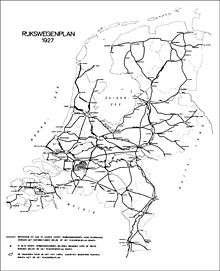
The country's first centrally-planned highway system dates back to the early 19th century, when Napoleon was emperor of France, and the Kingdom of Holland was annexed into the French empire. In 1811, Napoleon decreed that a network of 229 paved imperial roads (Routes Impériales) would be created, extending from Paris to the borders of his empire.[13][14] In addition to systematic paving, the roads were all numbered, an innovation at the time. Construction of several imperial highways through Holland commenced. Amsterdam was connected to Paris by Route Impériale no. 2, a section between Amsterdam and Utrecht is today still a part of the A2 motorway.
After the country's liberation in 1813, Hollands new king continued the project but with Amsterdam at the centre. The plan was expanded several times. In 1821, it projected 42 Rijksstraatwegen (literally: "Imperial paved roads"), which were built until 1850.[15] Since 1927, this network was transformed into today's system of Rijkswegen (national highways) in the Netherlands.[16]
The first motorway dates back to 1936, when the current A12 was opened to traffic between Voorburg and Zoetermeer, near The Hague. Motorway construction accelerated in the 1960s and 1970s but halted in the 1980s. Current motorway expansion mostly occurs outside the Randstad.
General maximum speed limits were introduced in 1957 (50 km/h within built-up areas), and in 1973 (100 km/h on extra-urban highways); the motorway limit was raised to 120 km/h in 1988.[17]
Roads by management
Roads are developed and maintained by authorities at all four administrative levels in the Netherlands. About 5,200 km of national roads (Rijkswegen) are controlled by central government agency Rijkswaterstaat, and the country's twelve provinces control about 7,800 km of provincial roads.[18][19] Most motorways are national roads, and the remaining national roads are mostly expressways. Only a few motorways are provincial ones, and they are much shorter and serve mostly regional traffic.[20] Frequently, they used to be national roads. Road numbers counting one or two digits (regardless of the preceding letter) are mostly national roads, but those with three numbers are typically provincial roads.
Municipality roads make up the bulk of the network, totalling some 120,000 km.[19] They are mostly local roads. Aside from the division in provinces, the Netherlands is also divided in 22 water management boards. Together with miscellaneous authorities, they own and control another 7,500 km of roads.[19] For some roads, it is because they are a physical element of water barriers, like dikes and dams while others provide primary access to critical water control structures and may not even be open to the public.
Roads by safety policy category
In 1997, the collective Dutch road management authorities reached agreement on a major traffic safety program, called Duurzaam Veilig ("Sustainable Safety"). One of its principles is a clear-cut categorisation of roads, into a small number of visually distinct and clearly recognisable designs, that must be applied consistently throughout the country. Three main categories were established:
- Stroomwegen (literally "Flow roads" or "Through roads"), aimed at a consistent flow of large amounts of motorised traffic, over long(er) distances, and with generally high speeds. In the design of these roads, traffic flow is consistently paramount, meaning: physical separation of traffic in opposite directions (ideally multiple carriageways), controlled highway access and grade separated junctions without traffic lights. Motorways and expressways fall into this category. General maximum speeds are 130 km/h for motorways, and 100 km/h for regional flow roads. In the long term, the new road type "regional flow road" will reshape the existing collection of non-motorway expressways (Autowegen) in the Netherlands.
- Gebiedsontsluitingswegen ("Distributor roads") prioritise traffic flow on road sections but traffic exchange at intersections. Fast and slow road users are separated, for instance cycle tracks are segregated from the main carriageway. Intersections are at grade, aimed at the most effective traffic exchange in terms of changing direction, road type or speed. Junctions are in the form of roundabouts where possible, or otherwise have traffic lights. For motor traffic, the speed limits are 80 km/h in the country and 50 or 70 km/h in the built-up area. Arterial roads fall in this category.
- Erftoegangswegen ("Access roads") connect individual properties to the rest of the road system. Traffic exchange takes place not only at intersections but also in between. Road users are pulling in and out of lots, and traffic modes mix. The street design must facilitate ingress and egress from vehicles as well as loading and unloading. A living function as well as a traffic function is intended. Speeds are therefore kept low: 60 km/h on rural or regional access roads, and 30 km/h on access roads in the built-up area, except for woonerfs (woonerven), where only 15 km/h is allowed. Out of town, there should ideally be separate cycle tracks or at least clearly painted bike lanes. In town, there can be cycle lanes, but on smaller 30 km/h roads, cyclists can typically mix with cars without problems. Among others, frontage roads and fietsstraten (bike streets) are considered to be access roads.
Roads by type
Outside of built-up areas

Autosnelweg, or simply snelweg, is the Dutch designation for motorways or freeways. They are controlled-access highways for fast motor vehicles only and are consistently built with multiple carriageways, guard rails and interchanges with overpasses. Since September 2012, the nationwide maximum speed has been raised to 130 km/h, but on many stretches, speed is still limited to 120 km/h or 100 km/h. Dutch motorways may only be used by motor vehicles both capable and legally allowed to go at least 60 km/h.
To improve traffic flow, a common feature of Dutch motorways is peak, rush hour or plus lanes, that allow motorists to use the hard shoulder in case of congestion. Less common but increasingly so, multiple carriageways are applied to separate local and regional traffic from through traffic. By splitting traffic in the same direction into parallel carriageways, the number of weaving motions across lanes is reduced, and the traffic capacity per lane of the road is optimised. Autosnelwegen are consistently numbered and signposted with an A and up to three digits, like A12. Motorways are by definition stroomwegen ("flow roads") and most of them are national roads: only a few shorter stretches are under provincial control.
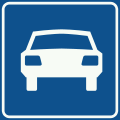
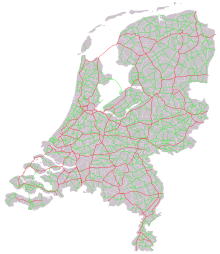
Autoweg is the legal designation for expressways that do not (fully) meet motorway standards. Although they are by definition limited-access highways for faster motor vehicles only, they were built to significantly varying standards. Designs range from dual carriageways, with shoulders and grade separation, and center dividers, to single carriageways with just one lane per direction, no traffic barrier, and only intermittent shoulder patches called Vluchthavens. Many intersections are at grade with traffic lights, or they are roundabouts. There can also be moveable bridges in these roads. In either of the latter cases, the speed limit is frequently reduced to 70 km/h before one reaches the junction or the bridge. The standard speed limit is 100 km/h, unless marked otherwise. Only motor vehicles both capable and legally allowed to go at least 50 km/h are allowed on an Autoweg.
Although Autowegen do not have to conform completely to the new Dutch design standard for regional flow roads (stroomwegen), many of these roads require at least some upgrades. Otherwise, they are downgraded to the safety category of distributor roads and so lose their expressway status.
Autowegen are always numbered and mostly signposted with an N (for Non motorway highway) and up to three digits, like N34. Almost all of these expressways are national or provincial roads.
Other Non motorway highways that are not expressways either are simpler in design, with level intersections and mostly single carriageways. Nevertheless, many of them feature adjacent bicycle tracks.
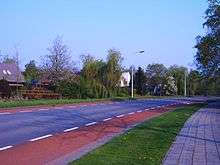
As far as these roads have (inter)regional significance, they are also numbered and to an extent signposted with an N and typically three digits. In that case, the roads are referred to as N-roads. These roads are mostly categorised as distributor roads, with a speed limit of 80 km/h. In principle, farm traffic and slow road users are allowed, but in many cases there are parallel roads like frontage roads or cycle tracks. In partially built-up rural areas, the speed limit may drop to 60 km/h, as indicated by signage. Provincial road N377 is an example of an N-road that is only partially an Autoweg.
Primary N-roads are numbered up to N400, and the numbers have to be on road signs. Although these roads can fall under any of the road management authorities, most are provincial roads. N-roads of secondary importance are numbered 401 through 999, but the numbers are not frequently signposted. They serve a more local function. Over time, they are transferred from provinces to municipalities, and the numbers are dropped.
From 1998 to 2007, more than 33,000 km of roads have been converted to regional access roads with a speed limit of 60 km/h,[8] so indicated by signage,[21] and frequently in zones.[22] Regional access roads are visually distinct from other roads having no center line marking. Slower vehicles and non-motorised traffic are allowed. Busier roads have adjacent cycle tracks, but quieter ones have advisory bike lanes. Again, they can fall under any of the road management authorities.
On extra-urban roundabouts, motor vehicles virtually always have priority over cycle tracks in the Netherlands.[23]
Within built-up areas
Inside of built-up areas, all roads are municipal. They are categorised only as either distributor roads or local access roads. Arterial roads and collector roads fall into the first category. Their maximum speed is 50 km/h except for arterials with a dual carriageway, which may be 70 km/h. Bicycle tracks have to be segregated.
Particular types of arterials are stadsroutes and city ring roads.
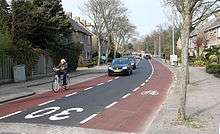
Stadsroutes (city routes) form a network of numbered arterials that connect parts of a city to a ring road or motorways running outside the city. City routes are signposted prefixed by an s and numbered from 100 or 101. When there is an s 100 present, it is an inner city ring road around the city centre. Stadsroutes can so far be found in seven Dutch cities: Amsterdam, Rotterdam, The Hague, Almere, Zaanstad, Heerlen and Nijmegen. Nijmegen has only its s 100 centre ring operational, but other routes are in progress. Heerlen also has only its s 100 ring right now, but it is shared with the nearby cities of Landgraaf and Kerkrade.
Contrary the way motorways and N-roads are numbered, city routes are not a national system. The same numbers can be used in every partaking city and are therefore not unique. Many other Dutch cities have constructed inner city ring arterials without numbering them (yet).
From 1998 through 2007, more than 41,000 km of city streets have been converted to local access roads with a speed limit of 30 km/h, for the purpose of traffic calming.[8] Local access streets include frontage roads, fietsstraten and woonerven although the legal status of the latter two is somewhat ambiguous.


Woonerf (literally "living yard") or legally just Erf, is the Dutch term for a specific implementation of living streets, abundantly applied throughout the 1970s and 1980s. Although not officially a part of the Sustainable Safety road categorisation policy, the woonerf is still a legally defined Dutch road type. The defining characteristic is that the living function of the street (walking, talking, playing) has official priority over its traffic function. Legally, pedestrians and children have priority over all other road users. They may use the full width of the street to walk and play. Road paving is more or less continuous. Under article 45 of the Dutch traffic code, motorised traffic in a woonerf is restricted to "walking pace", which the Dutch Supreme Court has ruled to be 15 km/h. Parking is also restricted.
Although woonerven have come under pressure from the drive to implement zones of 30 km/h local access streets, they are still prolific. In some places, new ones are still created, such as for space restrictions. In 2011, 20% of all Dutch homes were still located in woonerf areas,[24] and around 2 million people were living in woonerven.[25]
Fietsstraat (literally "cyclestreet") is not (yet) an official Dutch road type or category.[nb 3] The implementation comes down to paving the full width of the road (except for the sidewalk) as a cycle track, including the associated color. Signs are put up by the municipal authorities, informing motorists that they are guests and must yield to cyclists.
Correspondingly, the road portion of the street (between kerbs) is then legally considered to be a bicycle track with benefits instead of a road in the conventional sense.
Notable roads and statistics
As a side effect of the very dense road network, roadside / verge grass strips account for a full 3 percent of the Netherlands' total land area.
Most major motorways
The busiest Dutch motorway is the A13 between The Hague and Rotterdam, with a traffic volume of 140,000 motor vehicles per day.[28] The province of Utrecht in the centre of the country however, has the busiest motorways on average (almost 100,000 vehicles a day), with major motorways A1, A2, A12, A27 and A28 running through it.[28] The busiest four-lane motorway in the Netherlands is the A10 in the Coen Tunnel, in Amsterdam, with 110.000 vehicles per day. The widest Dutch motorway is the A15/A16, just south of Rotterdam, with 16 lanes, in a 4+4+4+4 setup.
As to the method: the number of passing motorised vehicles is counted every minute of the day at some 20,000 measuring stations on the Dutch motorway network.[28]
Carpool / H.O.V. and reversible lanes
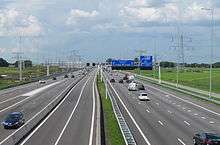
On 27 October 1993, the first "High-occupancy vehicle lane", (HOV-) or "Carpool" lane in Europe, was opened in the Netherlands, on the A1 motorway, which was simultaneously arranged as a reversible lane. It originally consisted of only one lane, available for either direction, for vehicles carrying at least three occupants.
On the very day of its official opening, former Dutch Minister of Transport and Water Management Tjerk Westerterp drove his car over the lane by himself, to provoke a trial case, to test the legality of such a road lane. After initial conviction in a civil court, the appeals court ruling determined, that the term "carpooling" at the time had no official meaning in Dutch law, nor the Dutch traffic code, and consequently, that the newly installed "carpooling" signage on this expressway lane entirely lacked all legal basis. Much to the disappointment of Westerterp, the court did not address the legal equality principle, which he presented as a fundamental issue in the case, to road users. In 1994, the reversible lane was opened to all traffic, regardless of occupancy.
The most significant case of reversible lanes in Holland is currently formed by one roadway tube of the second Coen Tunnel. Opened in 2013, the tunnel was built right next to the first Coen Tunnel of 1966, to greatly improve its capacity and alleviate severe daily congestion at the tunnel. One of the 2nd tunnel's two tubes, containing two lanes, is part of a 2-lane, 5 kilometre reversible road section.
The original section on the A1 motorway is currently under reconstruction, and will become an 8 kilometre (5 mile), mostly 2-lane reversible stretch, as part of a renovation involving motorways A1, A6 and A9, and is to be reopened in 2020.
See also
- Transport in the Netherlands
- Road transport in the Netherlands
- List of motorways in the Netherlands
- European E-roads in the Netherlands
- Rijksstraatweg - History of the first Dutch highway network
- National N-road route numbers (historic)
- Woonerf - a Dutch type of living street
- Fietsstraat (bike street) - a street design where bicycles have priority over cars
- Cycling in the Netherlands
Further reading
Sustainable Safety
Publications by SWOV, the Dutch Institute for Road Safety Research
- Advancing Sustainable Safety - full English language explanation for 2005-2020 (217 p.)
- Advancing Sustainable Safety (in brief) - brief English explanation for 2005-2020 (20 p.)
- De balans opgemaakt - Dutch language evaluation for 1998-2007, with English abstract (67 p.)
Notes
- Japan has the same per country road density,[4] but the Netherlands' area includes 18.4% water, compared to 0.8% for Japan.
- In 2012 a Dutch TV-show calculated that the centre dots alone of the country's roundabouts had a cumulative area greater than Vatican City.[10]
- Neighbour countries Germany and Belgium have adopted the fietsstraat concept into their traffic code; and Belgium included road signs based on a Dutch design.[26][27]
External links
- wegenwiki.nl - a Dutch wiki of over 19,000 articles, specifically about roads and motorways in the world. The wegenwiki has articles about most limited-access highways in the world. Of particular interest for non-Dutch visitors may be the historic opening dates, usually sorted in table form, so they are also accessible for people who do not speak Dutch.
- autosnelwegen.nl - Dutch website about their national roads, and specifically their motorways.
References
- "CIA World Factbook | Field listing: Roadways". cia.gov. U.S. Central Intelligence Agency. 2014. Retrieved 2015-08-17.
- "Road density (km of road per 100 sq. km of land area) | Data | Table". data.worldbank.org. The World Bank Group. 2014. Retrieved 2014-07-07.
- Road density - countries ranking, Knoema, Retrieved 2017-02-10
- "Road traffic, vehicles and networks | Environment at a Glance 2013: OECD Indicators" (PDF) (Press release). Paris, France: OECD Publishing. 2013. Retrieved 2014-07-10.
- "Autosnelweg - WegenWiki" [Motorway - WegenWiki]. wegenwiki.nl (in Dutch). 2012. Retrieved 2014-07-17.
- "The Netherlands boast almost 35,000 km of cycling paths". CROW - Dutch knowledge platform on cycling policy. 2012-10-25. Retrieved 18 July 2014.
- "Nederland telt bijna 35.000 km fietspad" [The Netherlands has almost 35,000 km of bicycle path] (in Dutch). Verkeerskunde.nl Dutch online platform for traffic engineering. 29 August 2012. Retrieved 12 August 2014.
- De balans opgemaakt: Duurzaam Veilig 1998-2007 [Sustainable Safety in the Netherlands - 1998-2007] (PDF) (in Dutch). SWOV, Dutch Institute for Road Safety Research. 2009. p. 6 (English abstract). ISBN 978-90-73946-06-4. Retrieved 13 July 2014.
- "Rotondes | IBM Cognos" [Roundabouts]. swov.nl (in Dutch). SWOV, Dutch Institute for Road Safety Research. 2012. Retrieved 2014-07-20.
- Wat kost een rotonde? [What are the costs of a roundabout?] (weekly) (TV-show) (in Dutch). KRO (Catholic Broadcasting Organisation). 2012-01-26. Event occurs at 19:58. Retrieved 2017-01-28.
- "SWOV Fact sheet | Mobility on Dutch roads" (PDF) (Press release). Leidschendam, the Netherlands: SWOV, Dutch Institute for Road Safety Research. July 2013. Archived from the original (PDF) on 2010-04-15. Retrieved 2014-07-07.
- Waard, Jan van der; Jorritsma, Peter; Immers, Ben (October 2012). "New Drivers in Mobility: What Moves the Dutch in 2012 and Beyond?" (PDF). ITF Discussion Papers. Delft, the Netherlands: OECD International Transport Forum. Archived (PDF) from the original on 2019-12-17. Retrieved 2014-07-07.
- Liste des routes impériales françaises de 1811 - Wikipédia
- Route impériale - Wikipedia (NL)
- "Autosnelwegen.nl - 1. 1795-1839 - Begin van een Rijkswegennet".
- "Rijkswegenplan 1927 - Wegenwiki".
- "1973-1991 - Oliecrises en de veranderende samenleving" [1973-1991 Oil crises and a changing society]. Autosnelwegen.nl (in Dutch). 2017. Archived from the original on 2017-01-29. Retrieved 2017-01-29.
- "CBS StatLine | Lengte van wegen, wegkenmerken, regio" [CBS Statline - Length of roads, road types]. statline.cbs.nl (in Dutch). Statistics Netherlands. 2013. Retrieved 2014-07-12.
- "Weglengte Nationaal WegenBestand (NWB) | IBM Cognos" [Road length | National Road Database]. swov.nl (in Dutch). SWOV, Dutch Institute for Road Safety Research. 2012. Retrieved 2014-07-17.
- Provinciale weg - Wikipedia (NL)
- Zaken, Ministerie van Algemene. "Wat betekenen de strepen op de weg? - Vraag en antwoord - Rijksoverheid.nl".
- "Erftoegangsweg - Wegenwiki".
- "Rotondes - Wat is veiliger, fietsers 'in' of 'uit de voorrang' op vrijliggende fietspaden ?" [What is safer - priority for cycle-tracks along roundabouts, or not ?]. SWOV.nl (in Dutch). SWOV, Dutch Institute for Road Safety Research. 2017. Retrieved 2017-01-28.
- "Sterke woonerfwijken: Voorkomen is beter dan herstructureren" [Strong woonerf areas: prevention beats restructuring] (in Dutch). Nicis-Platform31. 28 September 2011. Archived from the original on 1 April 2012. Retrieved 19 July 2014.
- Wassenberg, Frank; Lupi, Tineke (September 2011). Sterke woonerfwijken: Voorkomen is beter dan herstructureren [Strong woonerf areas: prevention beats restructuring] (in Dutch). The Hague, Netherlands: Nicis Institute. Retrieved 19 July 2014.
- "Belgische Wetgeving" [Belgian Traffic code] (in Dutch). Waddinxveen, Netherlands: Veringmeier Verkeersmanagement BV. 2012. Retrieved 2014-07-20.
- Fahrradstraße - Wikipedia (DE)
- A13 busiest national motorway in the Netherlands (PDF) (Report). Statistics Netherlands. 2014. p. 2. Archived (PDF) from the original on 2017-01-23. Retrieved 2017-01-23.
The A13 in the province of Zuid-Holland is the busiest motorway in the Netherlands.

